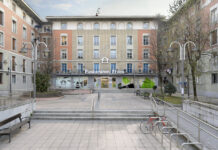It’s been a while since one of our favorite dailies has made an appearance on the blog. This would of course be The New York Times. The “Gray Lady” is a newspaper that speaks frequently, and highly, of the Basques, as can be seen in the many articles we’ve collected over the years.
On this occasion, Andrew Ferren brings us an article about how he and his family, including his son and daughter, enjoyed their holiday along the Basque Coast, from San Sebastian to Bilbao
Their stay focused on San Seastian, Getaria, and the Bilbao metro area. We only wish they had had time to also travel to the other side of the Pyrenees, or to experience the incredible landscapes Alava has to offer (including the Salt Valley of Añana), or the wineries of the Rioja Alavesa, or Navarre, from the legend-filled Pyrenees to the semi-desert moonscape of the Bardenas Reales.
What is clear is that they enjoyed their stay, a lot. It’s clear throughout the article.
But we must admit our eye caught on some of the author’s word choices. He chose to spell the town “Guecho” (with Spanish orthography) rather than “Getxo” (which is what appears on all signage), even though he spelled “Getaria” without the U Spanish spelling would require. He defined Juan Sebastián Elcano as “Spanish” despite the fact that Spain, as a political identity, didn’t even exist at the time he circumnavigated the globe; indeed, he wasn’t even Castilian, though he was a subject of the same king as the Castilians. Nevertheless, he does not define Magellan as Portuguese, even though he was.
We’d also like to point out that the architect of Vizcaya Bridge, Martín Alberto de Palacio Elissagüe, was also Basque: he was born in Labourd and died in Biscay. We’d also like to highlight that artist Cristina Iglesias was also born in Gipuzkoa; Chillida, too, was born in the Basque Country.
All that aside, we found the many readers’ comments on the newspaper’s website marvelous, showing just how much they love our country.
One of those comments seemed especially pertinent:
“A mix of proud and sadness. Donostia is loosing [sic] its soul due to Mass Tourism. This article will increase it. Travel, yes travel but stay quiet.”
We’ve said the same thing many times before. The risk of dying of success that a country as small, and attractive, as ours is huge. If we don’t do things right, we run the risk of becoming a sort of Basque theme park for tourists: all show, no soul.
Indeed, that’s the impression we sometimes get in the more touristy areas of San Sebastian and Bilbao. Our model of tourism cannot be, must not be, mass tourism. We run the risk of losing not only who we are, but also what makes us attractive in the first place.
The author of the article and his family comment that they’re going to return in summer. We would love for them to, and we hope they’ll go further afield, as well as discover some more of our culture and history. And that they’ll share all with the readers of the New York Times.
New York Times – 27-3-2023- USA
In the Basque Region of Spain: Art, Culture and a Puppy That Blooms
It’s not every beach stroll that leads to a modernist masterpiece, let alone one set in the sea amid crashing waves. After a bracing walk along the esplanade beside Ondarreta Beach in San Sebastián, Spain, I coaxed my family to keep going until we arrived at the western edge of La Concha Bay. There, anchored into the rocks and bashed by waves, was the 20th-century Spanish sculptor Eduardo Chillida’s “El Peine del Viento” (the Comb of the Wind): three nine-ton, rust-covered sculptures.
(Follow) (Automatic translation)
Header photo: Tabakalera is a sprawling, multipurpose art space inside a former cigarette factory in San Sebastian. Credit: Emilio Parra Doiztúa for The New York Times.
Last Updated on Dec 3, 2023 by About Basque Country






























